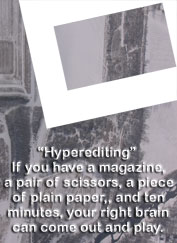.
There is a road between the west and east wings of the National Gallery of Art. Luckily they have provided us with a convenient underground passageway between the two wings, so we don't have to go out into the weather.
(Digression I seriously wish all of the museums had open-to-the-public underground passageways between them! You think to yourself "The Museum of American History is right next door to the Natural History Museum." And so it is. But they are so big that it's probably about a quarter of a mile from the door of one to the door of the other. And when the heat index is over 100, this matters..... End of Digression.)
There are slidewalks through here, but they were not operating on the 25th. This was good, from my perspective -- I got to take my time going through. I could stand still to take pics.
This is an art museum. This passage is lined with an art piece made by Villareal who made that nice sparkly piece over the staircase in the Renwick.
Here we are, getting ready to go in. The wall on the right is curved away from us the whole length of the passage.
The lights continually change. They seem to move from one end to the other, reversing direction from time to time.
Some times the light show is more interesting than other times.
And some times you get really lucky and can capture this. Very pleased with this one..... ("Boldly go" anyone??)
Wasn't it thoughtful of all those people to arrange themselves so photogenically at the eastern end?
The East Wing was under construction. The Calder wire "drawings" that are on my "always visit" list were not on view. Alas.
The building was open, but very little art was on display. Calder's enormous mobile in this huge atrium space was in its proper place, decorously turning in response to air currents.
Some guy was working on the roof. That's part of the enormous mobile between us and him.
I did venture up the stairs, but there wasn't much more to see from up there. Here is the orange part of the mobile, between us and some other work.
If I took paint chips and arranged them in a way that was pleasing, would my work get into the National Gallery? I doubt it. And yet -- how would my paint chips be different from this???? This is bigger, yes........
Does size impact whether or not something is art? And, if the contention is that it does, what is the defense for that position, I wonder......
We've gone back through the underground passage.
This is a self-portrait of Henri Matisse, done in 1937. I like the way he allows his glasses frames to overlap his eye.
Moving on, wandering around.
"Allies Day, May 1917" Childe Hassan
"Simplon Pass" John Singer Sargent, 1911. He's so well-known as a portraitist. I don't know that I've ever seen any other landscapes he has painted.
A very different sort of flower painting from the painstaking photographic realism of the Dutch in the 17th century.
This is all very misty, with only the foreground in focus at all.
"Flowers on a Window Ledge" 1861 John La Farge.
Another artist I am not familiar with.
"Mount Monadnock" "probably 1911/1914" Abbott Handerson Thayer
An impressionistic landscape.
"The Valley of the Seine from the Hills of Giverny" 1892 Theodore Robinson
Every pic I took of this one in its frame was blurry. This "painting, only" shot is better (but still not as sharp as I would wish). "Still Life of Flowers" 1868 Adelheid Dietrich
Sometimes you wonder about the frame. This very mundane subject, in this very fancy frame.... I suppose it's about how much the picture is valued, rather than about a frame that makes sense with its subject?
"Green Plums" 1885 Joseph Decker
You could see wooden boxes exactly like this at the
farmers' market now. Or, at least, you could have within the last several
years. Now, I guess fruit boxes are much more likely to be plastic, or ...
whatever you call that paper-pulp stuff egg cartons might be made of.
One of the themes recurring in my brain as I walked around art galleries was how much of the art had been commissioned/owned by rich white men, and how much of the subject matter was rich/powerful white men and their possessions.
As I noted when I was in the National Portrait Gallery, I think the people who decide what's displayed in galleries/museums are trying to display a more diverse collection.
They can't go back and time and see to it that more diverse likenesses are captured (or that a more diverse group of artists get a chance to have their work admired and preserved), but they can surely display what they have.
I don't remember seeing native Americans displayed in the National Gallery before. I was glad to see them now.
"White Cloud, Head Chief of the Iowas" 1844/1845 George Catlin
Unfortunately this man's name has been lost. I'm glad we get to enjoy his image.
"Portrait of a Ship's Steward" "probably 1829" and the artist's name is lost, as well as the name of the subject
"Montaigne Sainte-Victoire, from near Gardanne" Paul Cezanne 1887
I wonder if Cezanne considered this to be a finished work.
"Roses" 1890 Vincent Van Gogh
"Green Wheat Field" Vincent Van Gogh 1890
And here's what it looks like if you are able to stick your nose (and/or your camera) up close to the painting.
Poor old Vincent. I wonder if it would be a comfort to him, or a torment, to know how beloved his work would become.......
Self portrait, 1889.
.
Subscribe to:
Post Comments (Atom)









































No comments:
Post a Comment